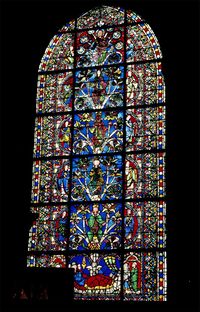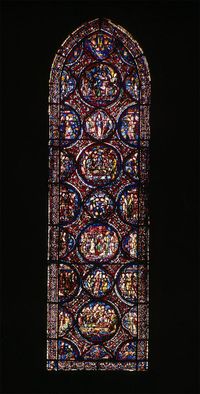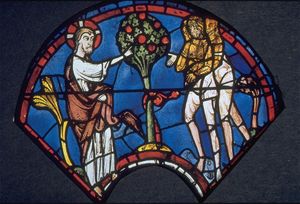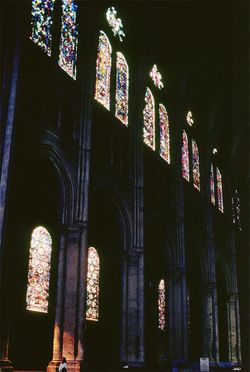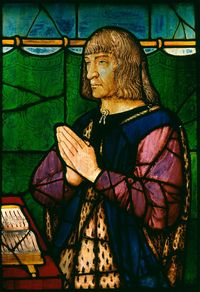Stained Glass Window
Imagine a world in which everything was bright and shining and new, a world in which one thing reflected off another in such a way as to enhance the attractiveness and beauty of both—and further, that the visual quality of reflection and transparency was an indication of a higher, moral order, an order which was the beginning of the ultimate reality, which, in a word, reflected heaven. This is the concept of ‘claritas’ as it was understood in terms of scholastic philosophy of the thirteenth century and probably earlier. It was the most highly prized of medieval visual qualities. (Reyntiens 1990, 20)
The stained glass window of the Middle Ages represents a profound intersection of material reality and spiritual vernacular. Though by no means an invention of the time, the medium fully matured and was articulated as never before in the walls of twelfth and thirteenth century European cathedrals. Many of these networks of glass and lead no longer survive. Those that do still speak today of their attempt to instill a sense of divine presence, manifest in light and color. Glass painting never went away, as countless examples demonstrate, but its trajectory and purpose were fundamentally altered during the Renaissance. This text will focus on developments particular to the twelfth and thirteenth centuries and draw primarily from French ecclesial architecture of the time.
Contents
Medieval Glass Painters
Stained glass is not so much a medieval craft, as a craft that was brought to perfection in the Middle Ages. (Reyntiens 1990, 8)
. . . its materials were arranged in such a way as to reveal their natural beauty—an arrangement which is not arbitrary but evident in the physical properties of the medium, in its ‘immutable laws.’ Such laws in the end define the medium. (Sowers 1954, 34)
Theology of Light and Color
And God said, “Let there be light,” and there was light. God saw that the light was good, and he separated the light from the darkness. (Genesis 1:3–4)
As a transparent as well as a colored material, glass resonated profoundly with the concepts of clarity and opacity that functioned as primary dichotomies for both moral and ontological systems. Light was transparent as it left the Creator, acquiring color, and thus its ability to be visible, as it penetrated the material world. Colors can therefore be seen as representing the diversity and imperfection of creatures, although they still betray the radiance of their origins. (Raguin 2003, 13)
For the evolution of stained glass the influence of the author known as the Pseudo-Dionysius is of paramount interest. . . . Writing in the sixth century, he produced two books which, brief though they were, proved to be highly influential. His two treatises, The Heavenly Names and The Celestial Hierarchies, which dealt with the composition of heaven and angels, in their ascending degrees of importance, were the inspiration of most theologians in the Middle Ages. From the point of view of the stained-glass artist these two books triggered-off the concept of light being the main constituent, if not the bed-rock, of matter. All was made of light, and the light was the material reflection of the heavenly light, the wisdom of God. (Reyntiens 1990, 19)
Isolated panels of glass which have survived indicate that the lives of the Old Testament patriarchs were recorded by the medieval glass painters. . . . The choice of some Old Testament subjects and the neglect of others is puzzling until it is realized that the selection was based on the belief that Old Testament events prefigured those of the New Testament. The choice was governed by typographical teaching. (Tasker 1993, 9)
It is a good instance of the homiletic basis of most medieval art, where the human figure is concerned. The windows are not so much the Bible of the poor as the proof that there was a vigorous tradition of preaching the Bible to the poor which cried out for illustration as a mnemonic after the sermon. (Reyntiens 1990, 48)
The doctrine of the ‘Communion of Saints’ was as old as Christianity itself, but it had particular importance so far as the study of stained glass is concerned. The doctrine was, briefly, that there is an unbroken web of contact and mutual help between those who have died in the favor of God and those, in the Church, who are yet on this earth. This difficult doctrine was such importance because the intercession of the saints on behalf of those still living meant that a cultus of the saints was a pressing necessity. This fact, together with the Doctrine of the Incarnation, which stated that the Christ, Jesus of Nazareth, was at one and the same time truly man and truly God, fixed the consciousness of western, Christian, art towards the human figure rather than abstraction or geometric non-figuration. And it is on the basis of figuration that all the glass in the Middle Ages, with very few exceptions, was founded. It is a case of ‘no cultus of the Saints, no Doctrine of the Incarnation—then no stained glass windows. (Reyntiens 1990, 22)
Architectural Space
One has the impression that the source of the light is in the colored glass itself and one has the feeling of being taken into distant space. (Tryggvadottir 1968)
The medieval lay masters wanted to master their materials, and to bend and fashion them in such a way that anything was possible. They vaulted huge spaces on slender points of support. They introduced light into their enormous covered spaces in such a way that this light itself constituted a kind of decoration, indeed painting. There were no longer walls but rather translucent tapestries. (Viollet-le-Duc 1990, 260)
Hitherto, with the close construction of Romanesque architecture, the individual widely spaced, deep-set windows piercing the thick walls afforded a series of separate experiences rather than a generally dispersed atmospheric experience. It was as though the viewer went from transparent icon to transparent icon as he progressed up the aisle. Suger, by employing the new flat-bed technique of construction, reduced the interval between the windows and cut down the bulk of the stone-work. Consequently the eye was enabled for the first time to take in a broad sweep of window expanse rather thn individual points of interest. This unifying gesture towards not only the windows but also the interaction of the windows with the architecture was the great breakthrough, and on this new formal reality the rest of the achievement of stained glass in the Middle Ages depended. (Reyntiens 1990, 25)
Imposed Aesthetics
Looking at the Portrait of King Louis XII, it’s clear that, by the sixteenth century, a naturalism had asserted itself in the art of stained glass. Opinions diverge as to whether Renaissance-era windows progressed beyond Medieval achievements. The scenes they depict are certainly more technically advanced but it seems something fundamental was lost. “After the Middle Ages,” writes Tryggvadottir, “its special characteristics were mainly ignored and neglected. Glass painting during the Renaissance was treated in the same manner as oil painting, rather than as a separate medium. But, in medieval times, the characteristics of glass as a medium were deeply appreciated, possibly because the medieval artist not only designed but also executed his own glass paintings.” (1968)
Sowers takes this argument even further, positing that the shift was determined by fashion, dishonest to the medium, and an insult to glasyers:
In the thirteenth century, stained glass had been part of a living cosmology of materials . . . By the sixteenth century it was not unusual for the glass painter to be given the task of imitating in stained glass a ‘school of Raphael’ fresco cartoon. Engraved reproductions of such works, by Marcantonio Raimondi and others, at the time were being circulated throughout Europe, and these were being accepted by the newly ascending mercantile patron as the final word in taste. Fine Art had been born and was beginning to be ‘applied’ to certain of the traditional arts. In this new hierarchy easel painting had become supreme and all of the other arts were practically shamed into imitating its effects. With his own standards of excellence thus revoked, the stained-glass artist, like the tapestry maker, illuminator, and mosaicist, was reduced to a common laborer, his traditional skills committed to the four winds. He was held to a formula alien not only to his instincts, but to the very nature of his medium. He could neither liberate himself from the structurally necessary network of leads nor could he any longer, in his effort to imitate the characteristics of painting, allow them to retain their normal decorative function. He had to try to hide them. Thus the ‘lost art’ of stained glass was never really lost; it was thrown away. (Sowers 1954, 26–27)
Much of Sowers thinking is informed by nineteenth century architect and theorist Eugène Viollet-le-Duc. Viollet-le-Duc’s Dictionnaire raisonné de l'architecture français is the product of research conducted as part of an effort to restore France’s great Gothic structures.
The builders of our cities do not seem to have been aware of these treasures. When one looks over our modern cities today, and one sees how devoid of splendor they appear, and most of them, how dreary, one wonders why modern architects have not taken advantage of the illuminating medium of stained glass, formerly so closely linked with architecture. (Tryggvadottir 1968)
Works Cited
Raguin, Virginia Chieffo. 2003. Stained Glass: From Its Origins to the Present. New York: Harry N. Abrams, Inc.
Reyntiens, Patrick. 1990. The Beauty of Stained Glass. London: The Herbert Press.
Sowers, Robert. 1954. The Lost Art: A Survey of One Thousand Years of Stained Glass. New York: George Wittenborn, Inc.
Tasker, Edward G. 1993. Encyclopedia of Medieval Church Art. London: B.T. Batsford Ltd.
Tryggvadottir, Nina. 1968. Painting with Light through Colored Glass. Leonardo, Vol. 1, No. 2. Cambridge: The MIT Press.
Viollet-le-Duc, Eugène-Emmanuel. 1990. The Foundations of Architecture: Selections from the Dictionnaire Raisonné. Translation by Kenneth D. Whitehead. New York: George Braziller, Inc.
